Preface
A CONVERSATION WITH A COLLEAGUE LAUNCHED THIS BOOK. She said that, a couple weeks into the semester, a student in her introductory psychology class had asked, “Why are we learning about biology? I signed up for a psychology course.”
This, we realized, was a very good question.
The student understood the biology. But he couldn’t relate the biological facts—
Introductory psychology does not have to be like this. Students do not have to study genetic mechanisms before understanding the psychological qualities that people may inherit. They don’t have to memorize brain structures before learning about the psychological phenomena that researchers try to understand more deeply by studying the brain. Most important, they do not have to wait until their book’s closing chapters to encounter the topic of greatest interest to them: the experiences of people, living in a social world—
Our Pedagogical Strategy
Psychology: The Science of Person, Mind, and Brain was written to execute this strategy, and thereby to improve students’ learning experiences in introductory psychology. The strategy itself is relatively simple; it consists of two steps.
Levels of Analysis
The first step is a levels-
Person: The whole individual, who develops as a member of groups, a society, and a culture
Mind: Mental representations, cognitive processes, and affective processes with which the cognitive processes interact
Brain: The massively interconnected neural systems that make it possible for us to have minds and to be persons
Programs of theory and research conducted at person, mind, and brain levels of analysis are not “competing perspectives.” They are mutually complementary routes to scientific understanding. In combination, they make today’s psychology a multifaceted yet integrated science.
A levels-
A “Person-First” Approach
With three levels of analysis, one has to decide where to start—
Psychology: The Science of Person, Mind, and Brain consistently starts “at the top.” We introduce a person-
Solving Pedagogical Problems
This two-
(1) Enhancing Student Engagement. Students look forward to introductory psychology; it sounds like one of the most interesting courses in the curriculum. But they often come away disappointed. They hope to learn about human experiences but instead find themselves slogging through technical topics they cannot directly relate to questions about people. Many thus become less engaged.
I was one of them. When I took the course in college, I learned relatively little about what I had thought was the field’s main target of investigation: people. It wasn’t just that the research subjects frequently were pigeons, rats, or dogs. The larger problem was that, even when humans came into view, they were so dissected into parts—
Our person-
Greater student engagement, in turn, enhances learning. “Interest,” one researcher explains, “motivates learning about something new and complex…. New knowledge, in turn, enables more things to be interesting” (Silvia, 2008, p. 59). A person-
(2) Maximizing Student Comprehension. Comprehension is highest when readers possess an intellectual framework into which they can “place” new material (Kintsch, 1994). In traditional introductory psychology textbooks, students lack this intellectual framework when encountering some of the field’s most technical content. The course instructor knows, for example, how neurotransmitter functioning bears on emotional experience and how neural interconnections enable conscious experience. The instructor thus can easily place biological facts into a psychological framework. But the student usually cannot. This may impede comprehension and recall of the biological facts.
Comprehension could be enhanced if introductory textbooks revisited the “lower-level” details after presenting “higher-
Psychology: The Science of Person, Mind, and Brain addresses this problem directly. Our person-
(3) Coverage That Is Integrated. A third benefit of our person-
I now understand that psychology is not, in reality, a hodge-
Our levels-
(4) Critical Thinking. We all want our students to think critically—
A person-
(5) Coverage That Is Up-
Today’s hybrid fields—
Another up-
In sum, thanks to our person-
Executing the Person-First Mission
The primary means through which Psychology: The Science of Person, Mind, and Brain executes its pedagogical strategy is through its novel organization of material within chapters.
Organization of Within-Chapter Coverage
Our levels-
Chapters that focus primarily at a mind or brain level of analysis (e.g., Chapter 6: Memory, or Chapter 3: The Brain and the Nervous System) nonetheless begin at a person level. Individual case studies and person-
level research findings provide an introduction to material that is readily understandable and that illustrates the personal and social significance of the information- processing and biological mechanisms covered later in the chapter. Chapters that focus at a person or mind level include coverage of the brain. ( Psychology: The Science of Person, Mind, and Brain does not confine its coverage of neural systems to one chapter of the text.) The brain level of analysis, however, is introduced only after the psychological principals are established—
which enables readers to comprehend the psychological significance of the brain research. Furthermore, the brain- level coverage reinforces the learning of psychological- level material presented previously.
Let’s preview a few chapters to see how the strategy is executed:
Chapter 3: The Brain and the Nervous System Most brain chapters begin with the smallest unit of analysis: the individual neuron. Unfortunately, the introductory student rarely can fathom how the functioning of a neuron relates to the psychological experiences of a person. By contrast, we begin with person-
focused examples that illustrate two features of the brain as a whole: networks (i.e., interconnections within the brain) and plasticity (experience- driven changes in brain matter). Both are the focus of contemporary, cutting- edge research. Yet both make it easier for students to comprehend the brain and its relation to psychology, because they relate directly to everyday psychological experience. Up- to- date coverage thus goes hand- in- hand with student comprehension and engagement. Chapter 4: Nature, Nurture, and Their Interaction Chapters on nature, nurture, and genetics commonly begin by reviewing the gene’s molecular structure. For many students, this is a rehash of high school biology that appears unrelated to questions about psychological experience and social behavior. We begin instead with a study of gene-
by- environment interaction that shows how genes and socioeconomic settings both contribute to a well- known personal quality, intelligence. This personfocused example is scientifically up- to- date yet easily comprehensible. Students quickly grasp the psychological significance of the material in the chapter ahead. Page xxvChapter 11: Motivation All introductory psychology textbooks review motivation and basic biological needs (e.g., hunger). But much of today’s science of motivation encompasses social needs, as well as socially acquired thinking processes through which people can influence their own motivational states. Our person-
level focus brings the full range of motivational processes into view. This simultaneously enhances student interest (everybody is interested in influencing their own level of motivation) and yields coverage that is fully up- to- date. Chapter 14: Development Some chapters on developmental begin with biological content: the biology of conception, fetal development, and brain development in prenatal, childhood, and adolescent periods. In this format, students have difficulty connecting the biological facts to developmental psychology (which they haven’t learned about yet). By contrast, we begin with the psychology, covering cognitive development and the brain only after the psychological principles are established. As a result, the chapter begins with a psychological topic of inherent interest to students; the significance of the subsequent biological material is more readily apparent to them; and material in different sections of the chapter is integrated.
The opening two chapters of Psychology: The Science of Person, Mind, and Brain also advance the book’s unique pedagogical strategy. In Chapter 1, students see how a socially relevant problem (gender stereotypes and math performance) can be addressed at complementary person, mind, and brain levels of analysis. Chapter 2, Research Methods, covers techniques used to study the social behavior of people, the workings of the mind, and the neural and biochemical mechanisms of the brain.
Finally, opening vignettes are one more organizational feature that promotes the person-
Chapter 1’s opening vignette introduces the theme of the book. It shows students how a compelling social phenomenon, stereotype threat, can be understood at person, mind, and brain levels of analysis. As promised, students do not have to wait to encounter the lives of people living in the social world.
Modular Organization
A second means of promoting a person-
The chapters of Psychology: The Science of Person, Mind, and Brain are arranged into four parts. After Introduction (Chapters 1 and 2), they correspond to our three levels of analysis: Brain (Chapters 3–
The parts are modular; after the completion of Chapters 1 and 2, they can be read in any order. Modularity provides flexibility—
A key to the book’s modularity is found in Chapter 2, Research Methods. The chapter introduces not only research designs but also methods of data collection, including methods used in cognitive science and in brain research. This coverage provides readers with background sufficient to understand phenomena and research findings presented in all later chapters of the book.
Visualizing Person, Mind, and Brain Levels of Analysis
Two features visually reinforce our levels-
PMB in Action integrates material found within each chapter of the text. This full-
PMB Connections integrates material between chapters. Readers see how a topic addressed at a given level of analysis in one chapter is also addressed, at different levels of analysis, in other chapters. For example, in our chapter on social psychology, a PMB Connections visual highlights the personal experience of cognitive dissonance and then points to research on memory (the dissonant ideas must be stored and associated) and the brain (neural systems involved in memory and emotion must be connected) that bears on the person-
Enrichment Features
Each chapter contains enrichment features that expose readers to key topics in psychological science. These features are not “boxed” and thereby segregated from the flow of text, where they may be skipped by readers. Instead, they are integrated into the narrative and placed at points where they deepen readers’ understanding of overall chapter material. Our three enrichment features are Research Toolkit, Cultural Opportunities, and This Just In.
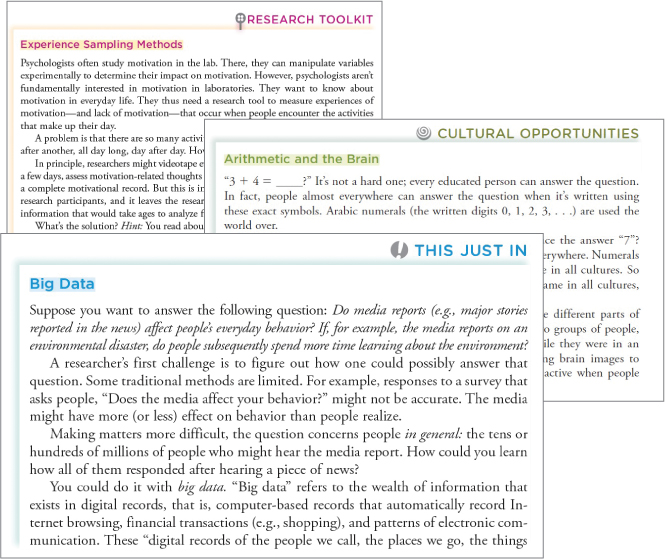
Research Toolkit
In each subfield of psychology, researchers employ specialized data-
Some textbooks compartmentalize research methods, with all discussion of methodology appearing in one early chapter. The drawback is plain to see. Early in the semester, students are unfamiliar with the substantive scientific questions that the methods are designed to answer.
Rather than compartmentalizing methods coverage, Psychology: The Science of Person, Mind, and Brain distributes it throughout the text. In addition to a foundational research methods chapter (Chapter 2), each subsequent chapter of the text presents a research technique germane to that chapter’s topic. This is done in a Research Toolkit feature. Each Research Toolkit describes a scientific challenge, encourages students to think critically about it, and presents a research tool that provides a solution. The Research Toolkit thus covers methods where they can best be understood: within the context of the substantive psychological questions.
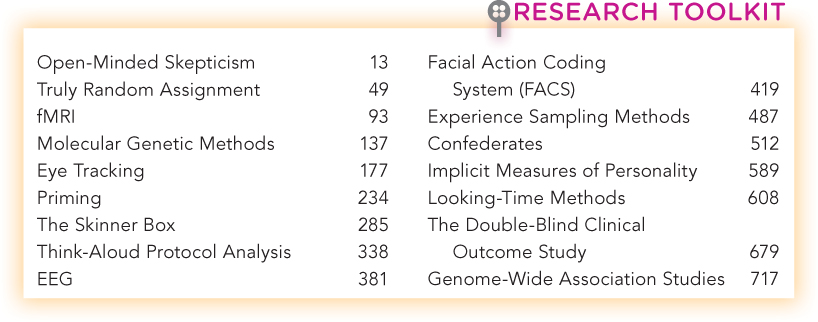
Cultural Opportunities
Some textbooks discuss culture in only one section of the book (e.g., within a social psychology chapter). This compartmentalization conflicts with the findings of today’s psychological science. Cultural beliefs and practices shape the developing person, the mind, and the brain—
In order to capture these scientific advances, each chapter of Psychology: The Science of Person, Mind, and Brain contains an enrichment feature called Cultural Opportunities. It showcases findings from the study of psychology and culture that address fundamental questions in psychological science.
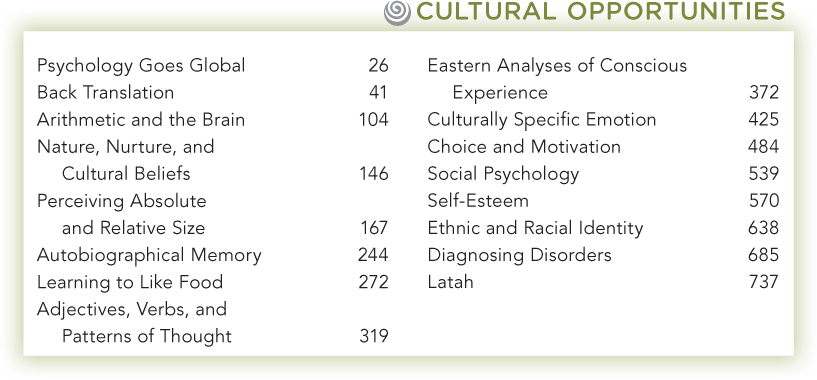
This Just In
We’re bombarded daily—
In addition to providing information about recent findings, This Just In teaches a more general lesson. The introductory student needs to understand not only that psychology is a science, but also that it is a rapidly evolving one. Advances in theory and research—
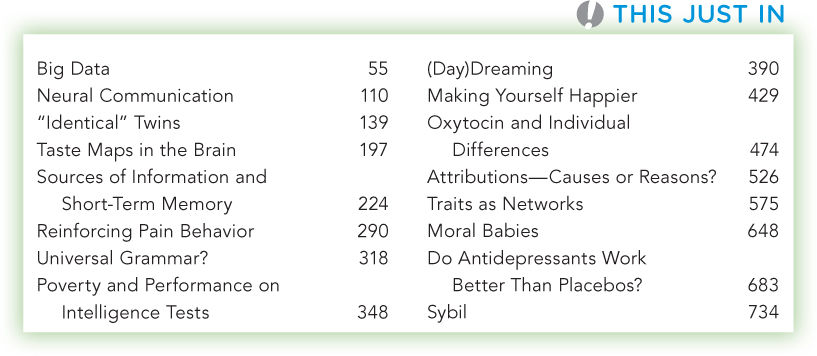
Integrated Media: Try This!
Psychology: The Science of Person, Mind, and Brain uniquely integrates the textbook experience with research experience. Readers take part in the methods of psychological science thanks to a feature called Try This!

In each chapter, readers are directed to our Web site, www.pmbpsychology.com, where they are invited to take part in a Try This! research experience. The Web site provides feedback on users’ own results and compares those results with published research findings. After readers return to the text, they learn more about the research experience in their subsequent reading.
Try This! creates a uniquely active textbook experience. Readers learn—
Pedagogical Program
In some textbooks, the pedagogical program is literally an afterthought—
The pedagogy is designed around Bloom’s Taxonomy of Educational Objectives, a systematic enumeration of learning objectives developed by the educational psychologist Benjamin Bloom and revised subsequently by psychologists and education researchers (Krathwohl, 2002; Munzenmaier & Rubin, 2013). The objectives move far beyond the simple first goal of retaining knowledge of basic facts. As Bloom’s Taxonomy recognizes, course instructors want students to acquire deeper intellectual skills: comprehending material (interpreting its meaning and extrapolating beyond information provided), applying knowledge (e.g., using a concept to solve problems), analyzing information (breaking down complex phenomena into constituent parts), synthesizing material (generating a novel intellectual product by relating ideas to one another), and evaluating concepts and findings (judging their relative worth). These learning objectives—
Readers benefit from a range of pedagogical features that pursue various levels in this set of educational objectives:
Preview Questions placed before major chapter subsections pose questions that are answered in the reading. The questions highlight for readers upcoming points that are particularly important for study and comprehension.

Chapter Summaries repeat those questions and provide a set of answers that serve as a synopsis of each chapter as a whole.
Think About It asks students to pause and reflect on topics from the perspective of a psychological scientist —to question theoretical claims, interpretations of research, and the generalizability of research findings across social settings and cultures.

In Your Life questions that appear throughout each chapter help students identify applications of scientific material to their everyday lives. This feature reinforces the book’s consistent aim of showing readers the relevance of psychological science to everyday life.
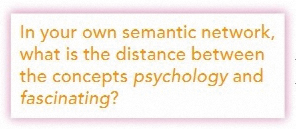
What Do You Know? assessments, which appear at the end of each section, give students an opportunity to immediately test their own learning. What Do You Know? questions typically target the knowledge and comprehension levels and occasionally the analysis level of Bloom’s Taxonomy of Educational Objectives.
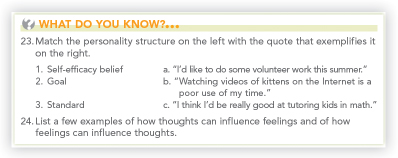
Questions for Discussion found in end-
of- chapter material support the achievement of higher levels of Bloom’s taxonomy— up through Level 6, Evaluation. The broad, open- ended Questions for Discussion, which can form the basis for class discussion, are a natural springboard to application, analysis, synthesis, and evaluation— the critical thinking skills that comprise higher levels of Bloom’s Taxonomy. An end-
of- chapter Self- Test, consisting of 15 multiple-choice questions, is designed to challenge students through the first four Bloom’s Taxonomy levels.
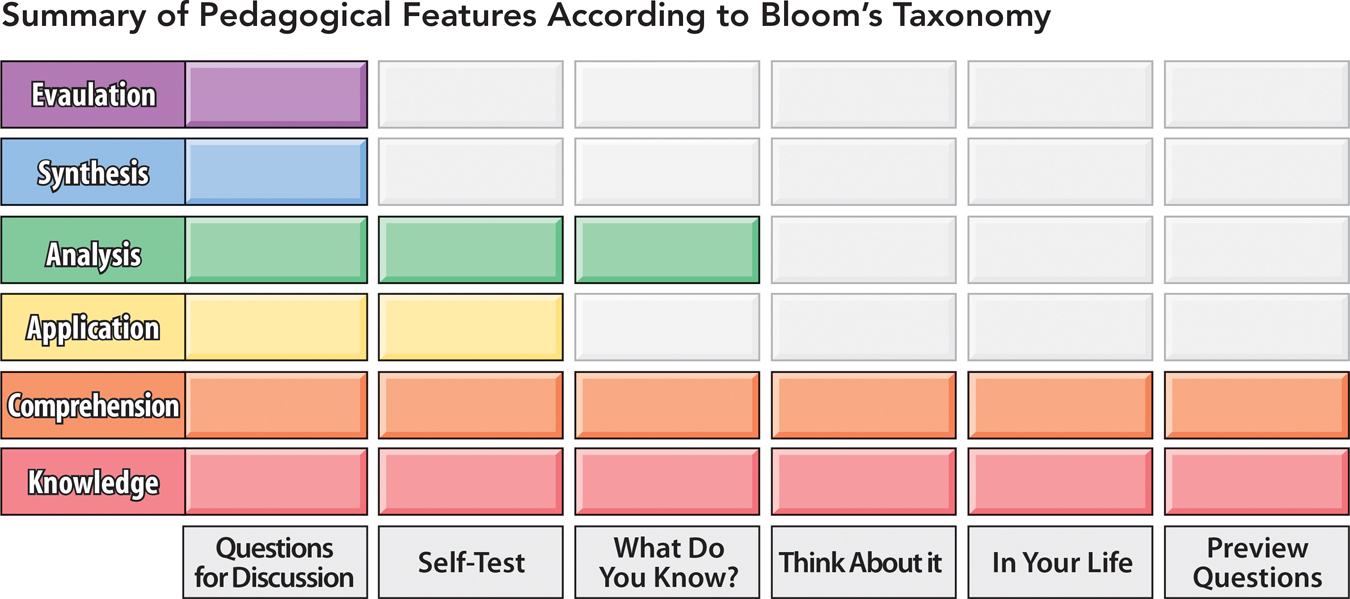
Alignment with APA Guidelines and MCAT 2015
APA Learning Guidelines 2.0
In order to support students’ undergraduate experience in psychology as well as career development, the content in Psychology: The Science of Person, Mind, and Brain is aligned with The APA Guidelines for the Undergraduate Psychology Major 2.0. These guidelines present a rigorous standard for what students should gain from foundational courses as well as the complete major. A full concordance to the APA guidelines is posted in the Resources area of LaunchPad at www.macmillanhighered.com/
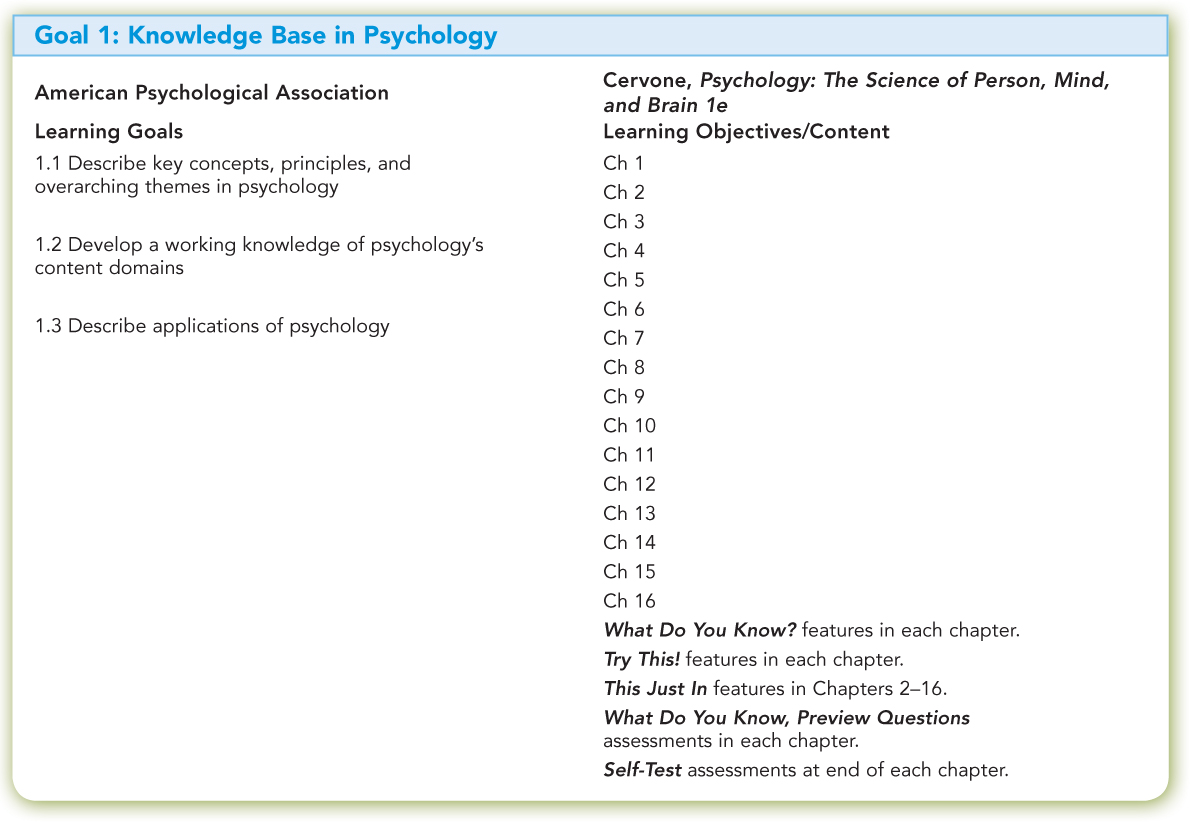
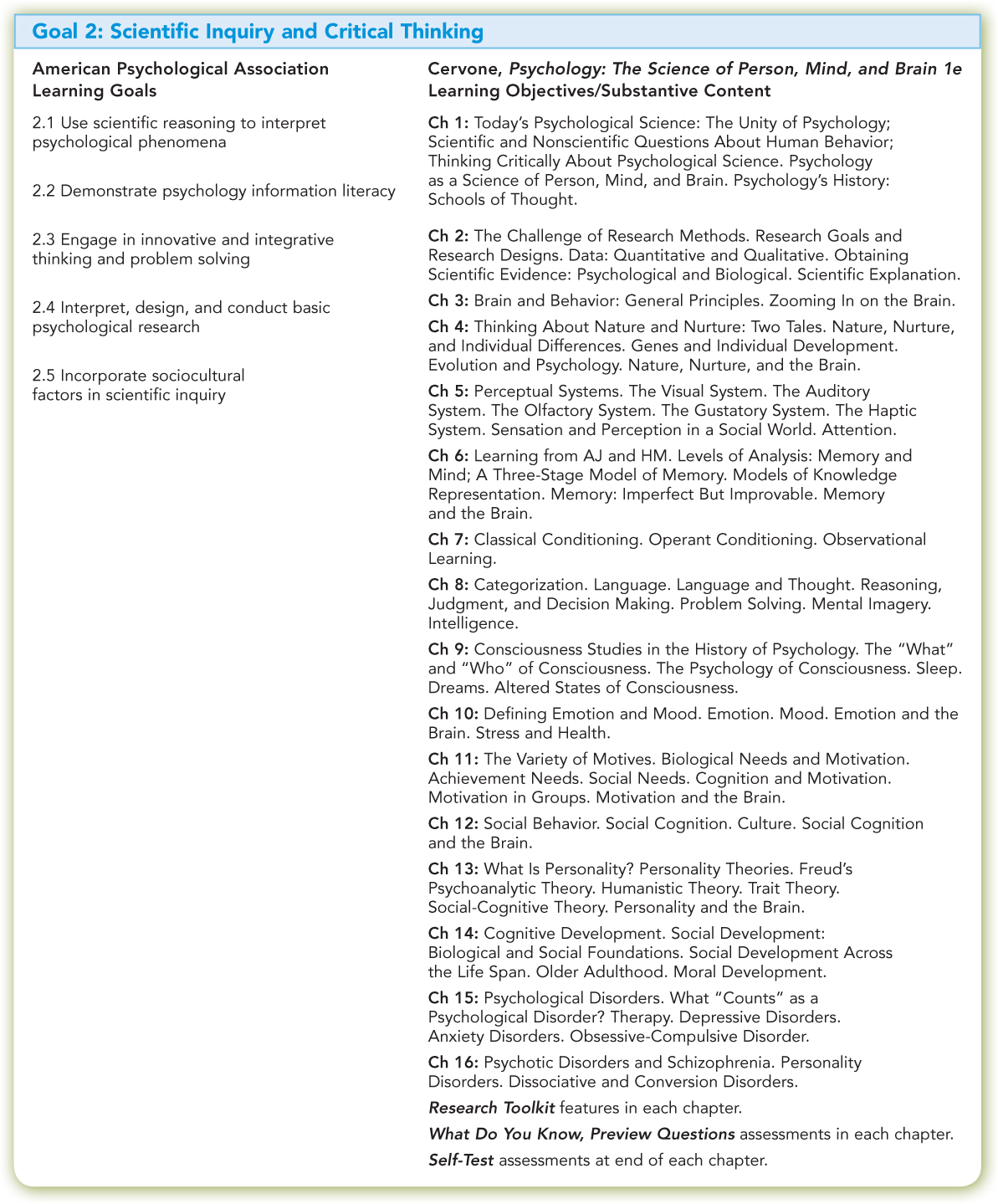
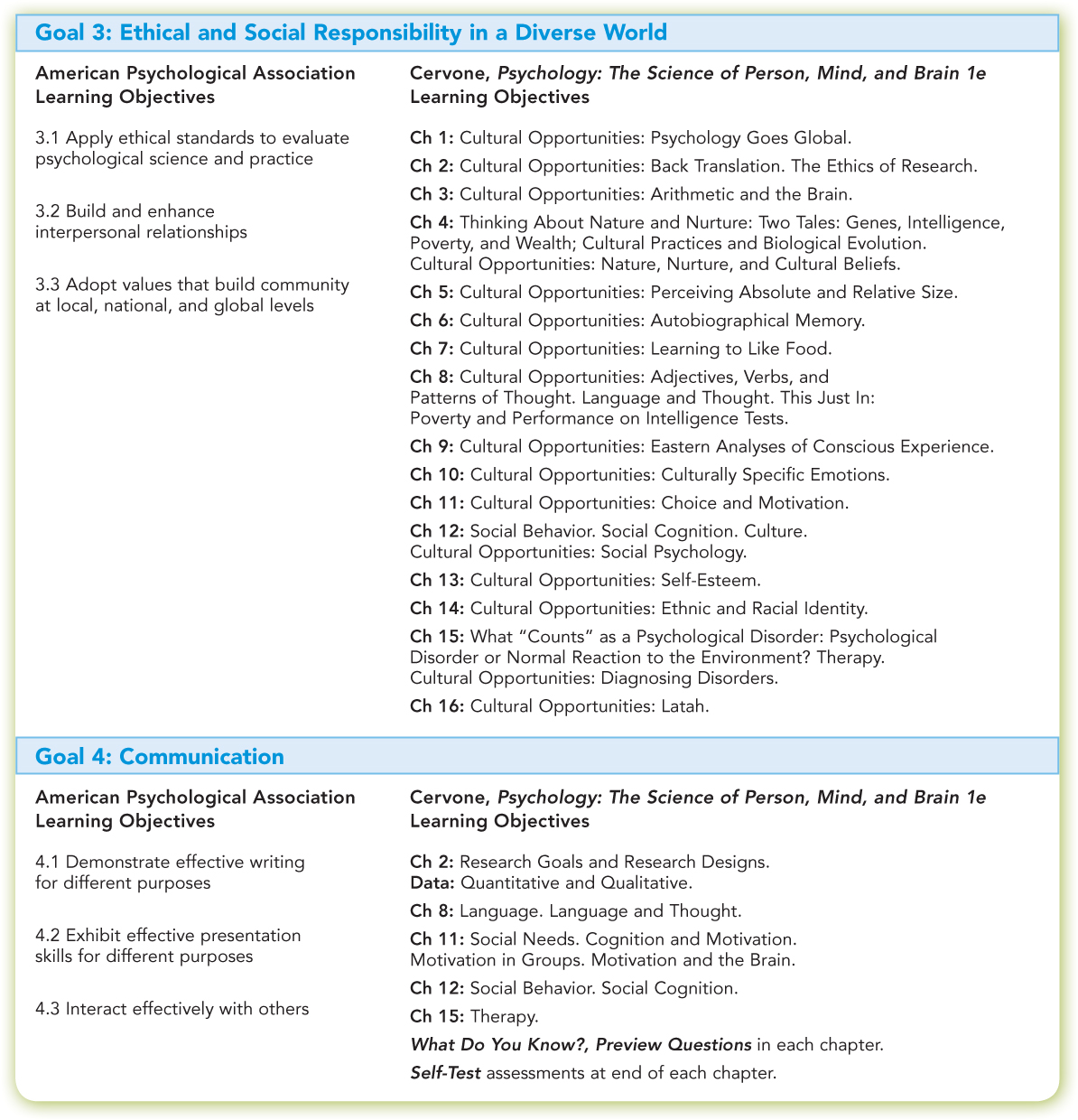

Psychology and MCAT 2015
The Medical College Admission Test (MCAT) began including test items assessing knowledge of psychology in 2015. One-
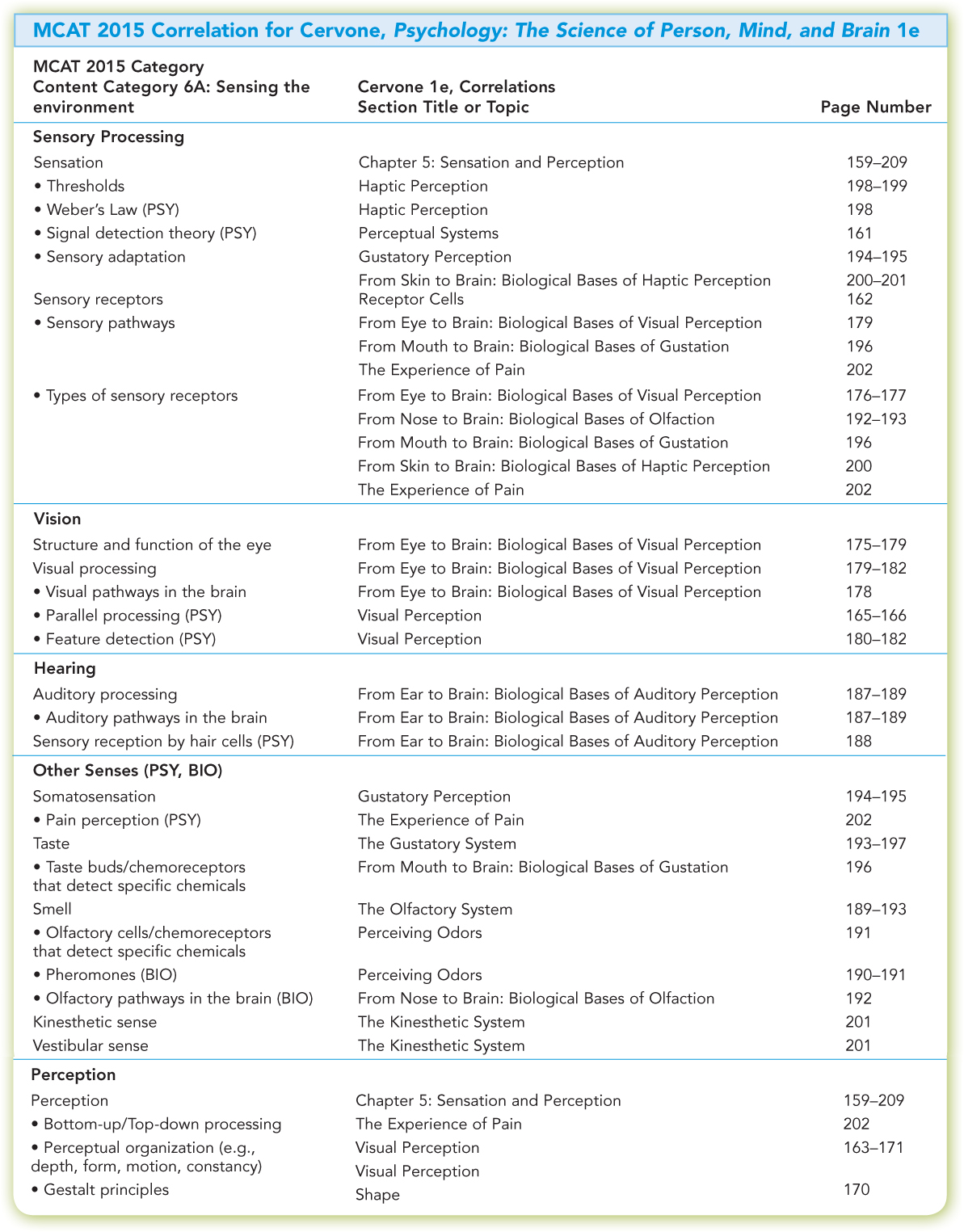
Thanks!
I once thought I’d employ the phrase “It takes a village” in this thank-
Jenny DeGroot and Nicholas DeGroot Cervone observed years of oddities. Most people don’t bring their work computer on “vacation.” Other parents were not typing rapidly during time-
Thanks also to family in Florida for kindly asking, “How is your book going?” at every holiday season. On a much more serious note, during the course of the writing, our family suffered a tragic loss that was attributable to a psychological disorder. Nothing can lessen the pain of such events. But they do motivate the author to craft a textbook that might inspire some readers to enter into and eventually advance this field in a way that may improve treatments for psychological distress (a motivation reflected in this book’s dedication).
Numerous individuals provided information to the author throughout the years of writing. Colleagues at the Department of Psychology at the University of Illinois at Chicago generously shared their knowledge of topics ranging from neurotransmitters to cognitive science to communities and cultures. Friends outside psychology have kept me up-
My experience teaching introductory psychology at UIC has greatly benefited the present work. Undergraduates’ moments of comprehension and puzzlement, interest and occasional boredom provided clues as to how best to structure material. Remarkably skilled graduate teaching assistants at UIC frequently shared insights into ways of enhancing undergraduate students’ engagement in, and comprehension of, psychological science.
I’d like also to acknowledge earlier academic experiences that placed me in a position to write this book. The faculty at Oberlin College provided an extraordinarily hands-
Four colleagues deserve special thanks. During our years of co-
Throughout the preparation of this book, we benefited from the insights of a large team of chapter reviewers and focus group attendees.
Carol Lynn Anderson
Bellevue College
Jessyca Arthur-
Manhattanville College
Josh Avera
De Anza College
Jeffrey Baker
Monroe Community College
Cynthia Barkley
California State University, East Bay
Dave Baskind
Delta College
Rinad Beidas
Temple University
Danny Benbassat
George Washington University
Joseph Benz
University of Nebraska at Kearney
Garrett Berman
Roger Williams University
Matthew Blankenship
Western Illinois University
John Broida
University of Southern Maine
Michelle Renae Byrd
Eastern Michigan University
Jessica Cail
Pepperdine University
Kevin M. Chun
University of San Francisco
Sheree Conrad
University of Massachusetts
Kristi Cordell-
Angelo State University
Ginean Crawford
Rowan University
Deanna DeGidio
Cuyahoga Community College Eastern Campus
Christopher Dehon
Monroe Community College
Daneen Deptula
Fitchburg State University
Nick Dominello
Penn State University
Dale Doty
Monroe Community College
Curtis Dunkel
Western Illinois University
Frederick Elias
California State University, Northridge
Renee Engeln
Northwestern University
Staussa C. Ervin
Tarrant County College, South
Todd Farris
Los Angeles Valley College
Dan Fawaz
Georgia Perimeter College
Diane Feibel
University of Cincinnati—
Adam Fingerhut
Loyola Marymount University
Donna Fisher Thompson
Niagara University
Claire Ford
Bridgewater State University
Alan Fridlund
University of California, Santa Barbara
Erica Gannon
Clayton State University
Marilyn Gibbons-
Southwest Texas State University
Bryan Gibson
Central Michigan University
Jennifer Gibson
Tarleton State University
Jamie Lynn Goldenberg
University of South Florida
Jennifer Gonder
Farmingdale State College, SUNY
Chris Goode
Georgia State University
Wind Goodfriend
Buena Vista University
Jeffrey Goodman
University of Wisconsin-
Cameron L. Gordon
University of North Carolina Wilmington
Ray Gordon
Bristol Community College
Jonathan Gore
Eastern Kentucky University
Raymond J. Green
Texas A&M University-
LaShonda Greene-
La Salle University
Sheila Greenlee
Christopher Newport University
Robert Guttentag
University of North Carolina at Greensboro
Shawn Haake
Iowa Central Community College
Meara Habashi
University of Iowa
Justin David Hackett
University of Houston-
Sowon Hahn
University of Oklahoma
Carrie Hall
Miami University (OH)
Deletha Hardin
The University of Tampa
Christian L. Hart
Texas Woman’s University
Mark Hauber
Hunter College
Erin Henshaw
Eastern Michigan University
Julie Hernandez
Rock Valley College
Sachi Horback
Bucks County Community College
Allen Huffcutt
Bradley University
Charles Huffman
James Madison University
Jack Kahn
Curry College
Donald Kates
College of DuPage
Julie Kiotas
Pasadena City College
Laura Kirsch
Curry College
Laura Knight
Indiana University of Pennsylvania
Tim Koeltzow
Bradley University
Gordon D. Lamb
Sam Houston State University
Mark Laumakis
San Diego State University
Natalie Lawrence
James Madison University
Marlene Leeper
Tarrant County College, Northeast
Kenneth J. Leising
Texas Christian University
Fabio Leite
The Ohio State University at Lima
Barbara Lewis
Susquehanna University
Christine Lofgren
University of California, Irvine
Nicolette Lopez
University of Texas at Arlington
Ben Lovett
Elmira College
Martha Low
Winston-
Pamela Ludemann
Framingham State University
Margaret Lynch
San Francisco State University
Amy Lyndon
East Carolina University
Jason Lyons
Tarleton State University
Lynda Mae
Arizona State University
Thomas Malloy
Rhode Island College
Michael Mangan
University of New Hampshire
Karen Marsh
University of Minnesota Duluth
Man’Dee Kameron Mason
Tarleton State University
Dawn McBride
Illinois State University
Todd J. McCallum
Case Western Reserve University
Yvonne McCoy
Tarrant County College, Northeast
Ticily Medley
Tarrant County College, South
Ronald Mehiel
Shippensburg University
Diana Milillo
Nassau Community College
Dan Miller
Indiana University—
Dennis Miller
University of Missouri
Robin Morgan
Indiana University Southeast
Laura Naumann
Sonoma State University
Bryan Neighbors
Southwestern University
Todd Nelson
California State University, Stanislaus
Glenda G. Nichols
Tarrant County College, South
Arthur Olguin
Santa Barbara City College
Lynn Olzak
Miami University (OH)
Charles Thomas Overstreet, Jr.
Tarrant County College, South
John Pierce
Villanova University
Thomas G. Plante
Santa Clara University
Laura Ramsey
Bridgewater State University
Heather J. Rice
Washington University in St. Louis
Vicki Ritts
St. Louis Community College, Meramec
Ronald Ruiz
Riverside City College
Shannon Rich Scott
Texas Woman’s University
Sandra Sego
American International College
Gregory Shelley
Kutztown University
Teow-
Sam Houston State University
Jesse Tauriac
Lasell College
Paul Thibodeau
Oberlin College
Felicia Thomas
California State Polytechnic University, Pomona
Donna Thompson
Midland College
Michelle Tomaszycki
Wayne State University
Jan Tornick
University of New Hampshire
Jose Velarde
Tarrant County College, Southeast
Jeffrey Wagman
Illinois State University
Nancy Woehrle
Wittenberg University
Brandy Young
Cypress College
Ryan Zayac
University of North Alabama
Zane Zheng
Lasell College
A huge thank-
A remarkable team of professionals at Worth Publishers is responsible for this book’s production. The energy and creativity of Senior Acquisitions Editor Dan DeBonis were crucial in bringing the project to fruition. Worth Publisher Rachel Losh, Assistant Editor Nadina Persaud, Editorial Assistant Katie Pachnos, and Managing Editor Lisa Kinne provided additional key support. The production process has also benefited from the work of Worth’s Director of Editing, Design, and Media Production for the Sciences and Social Sciences, Tracey Kuehn; Executive Media Editor, Rachel Comerford; and Production Manager, Sarah Segal. Preparation of the manuscript was speeded by the reference-
The writing has benefited from the skills of two exceptional Developmental Editors. Mimi Melek provided critical instructive feedback throughout the book’s early development. The subsequent contributions of Cathy Crow were so extensive, so constructive, and executed so efficiently that I cannot help but wonder if, in reality, a team of professionals was working under the pen name “Cathy Crow.”
Finally, thanks to two Worth professionals without whom we would not be here. Catherine Woods’s confidence in the project at its outset is deeply appreciated. Once under way, the work was nurtured for years by the wisdom and warmth of Kevin Feyen, who contributed immeasurably to the final product.
Acknowledgments
Although the main text of this book is sole-
These communications occurred shortly before Dr. Caldwell joined the faculty at Dominican. Because the assistant-
We jointly thank Worth Publishers for their incredible professionalism and support.
University of Illinois at Chicago
